How the regen farming route works for a downland dairy
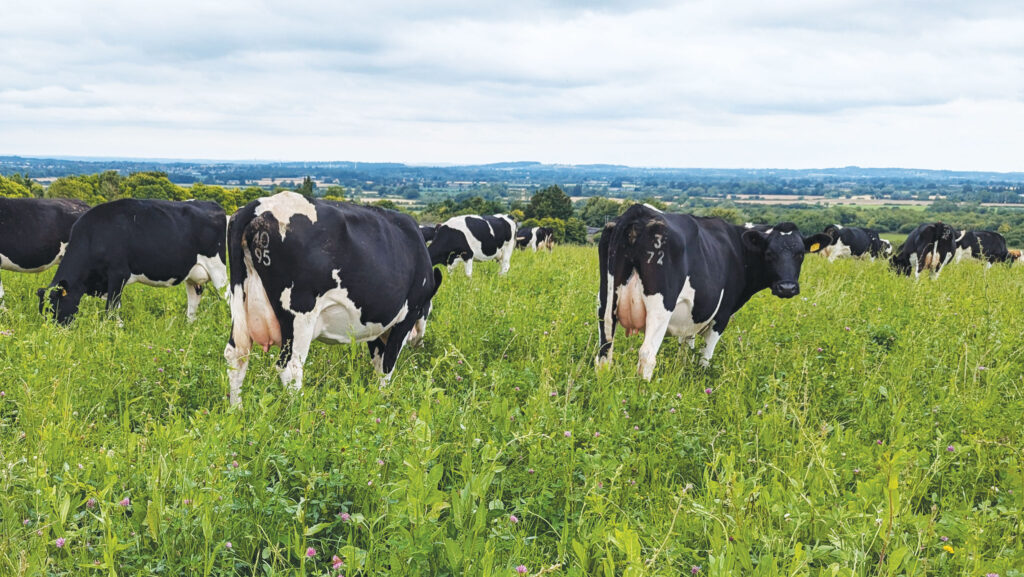 © Sophie Wilson
© Sophie Wilson Dai and Sophie Wilson have opted for a low-cost, low-input dairy system, which suits the uniqueness of their land and allows for the nature-friendly, high-welfare enterprise they want.
Farm vet Sophie says that they didn’t want to get trapped in the spiral of making feed, feeding more, and chasing yield.
“You can end up on a treadmill: pushing production, increasing inputs like feed, labour and machinery, then needing even more output to cover the increased costs,” she explains.
See also: Advice on setting up a dairy grazing rotation
Instead, the Wilsons focus on healthier soils and cows, as well as growing more grass with less input.
They trialled this sort of dairy system in 2019 while on a contract farming agreement with Sophie’s parents before joining the family partnership at Eastbrook and Starveall Farms in Bishopstone, Wiltshire.
Farm facts
- Organic dairy, supplying Arla
- Arable and pig enterprises also in the family partnership, which includes Sophie’s parents
- 729ha – of which 405ha are chalky downland
- 510 cows
- Milked once a day
- 3,600 litres at 4.5% butterfat and 3.6% protein
- Three full-time staff and two relief staff
Now, they milk 510 cows once a day and outwinter the herd.
Cows are split across two units – the main tenanted farmstead and a dairy Sophie and Dai designed and started in 2019, which is located 198m above sea level, rising to 264m in places on the chalk downland.
Having already switched the autumn calvers to a spring block, the two herds are “more and more” treated as one enterprise.
“We manage them very similarly and can switch cows between the two if we need to, to balance up numbers for grazing,” says Sophie.
Low rainfall
Dai says they originally set out to do 5,000 litres from 1t of cake, three-leaf grazing and maximum forage quality.
However, after two years they decided it did not suit their farm because they were making silage to feed it back straight away and running out of grass.
“Annual rainfall would be around 625-650mm, but it never came when we needed it. We’re short in the spring and there’s loads of it in the winter,” he adds.
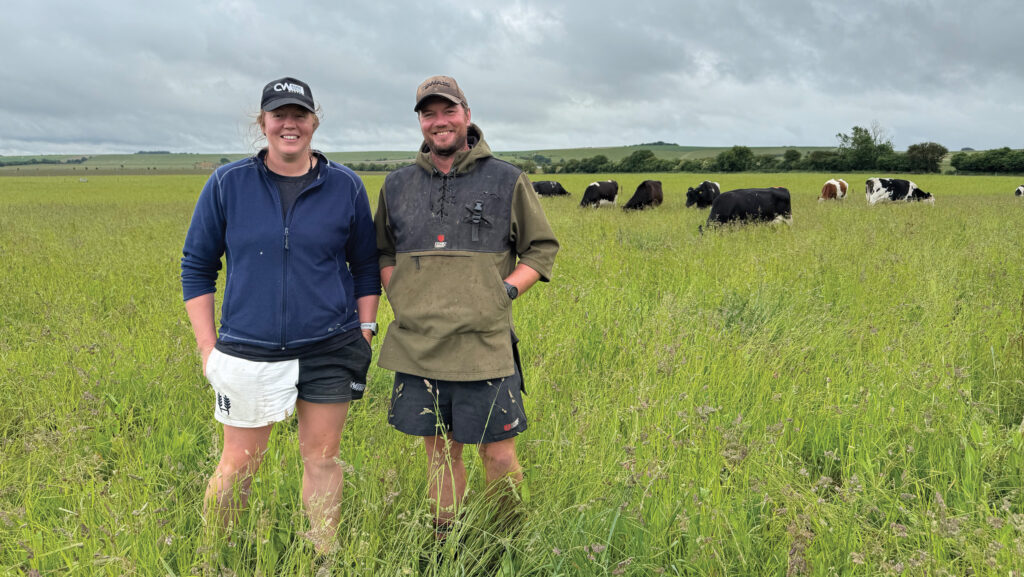
Sophie and Dai Wilson © Hayley Chapman
Most of the grazing platform, on chalky and free-draining soils, is now in longer term herbal leys with a diverse mix of species.
They have reduced the proportion of red clover in the sward and included more lucerne.
This was mostly due to concerns about bloat and because they found the red clover was leaving bare patches in the sward when it died back after the first couple of seasons.
“The original system was a lot of work and costing more money, so we started letting grass grow taller.
“We didn’t have to make bales, and we deferred the spring surplus to let cows graze it in summer,” explains Dai.
“It’s arguably lower quality, but we grow more grass in total and it’s more diverse so copes better with being trampled.
“As long as you graze it reasonably tight once or twice a year, you can reset the quality before the next spring.”
Cows can head into the taller grass when the farm dries up in July/August and it provides forage without the use of machinery.
Sophie adds that the more diverse the leys, the better they hold up, in contrast to the “big mat of flattened ryegrass” they saw when they first started deferring grazing.
The Wilsons are more interested in measuring round lengths and rest periods than covers and residuals.
Depending on the time of year, entry covers can range from 2,500-5,000kg dry matter a hectare.
Rest and rotation
In early spring, they aim for a 30-day rest period; that increases to 50-60 days for a good chunk of the year and to 90-100 days after bale grazing.
“In early spring, we probably do a fairly typical paddock-style grazing system.
“Once that surplus starts to build up, it becomes more like mob-grazing with higher covers and higher residuals, with moves every 12-24 hours,” says Sophie.
No routine reseeds are planned, as such, but 5-10ha of the farm are used for a pig enterprise each year, and this area is cultivated and reseeded afterwards.
Soil health is an absolute priority and big factor in all decision-making.
The aim is high organic matter, free-draining soil with good biology to enable it to absorb rain, and handle drought and cow impact.
“We’re trying to get healthier soils, so we can grow more grass, then we can milk more cows and make more money,” says Dai.
Something Sophie learned on a course run by Integrity Soils was the importance of fungi in the soil, and they hope to improve content on their land through reducing cultivations.
“We have low levels of fungi and high levels of bacteria from historically frequent cultivation and that creates quite a tight soil.
“Fungi act like an extension of your roots and that fungal network can help plants access nutrients and water,” she says.
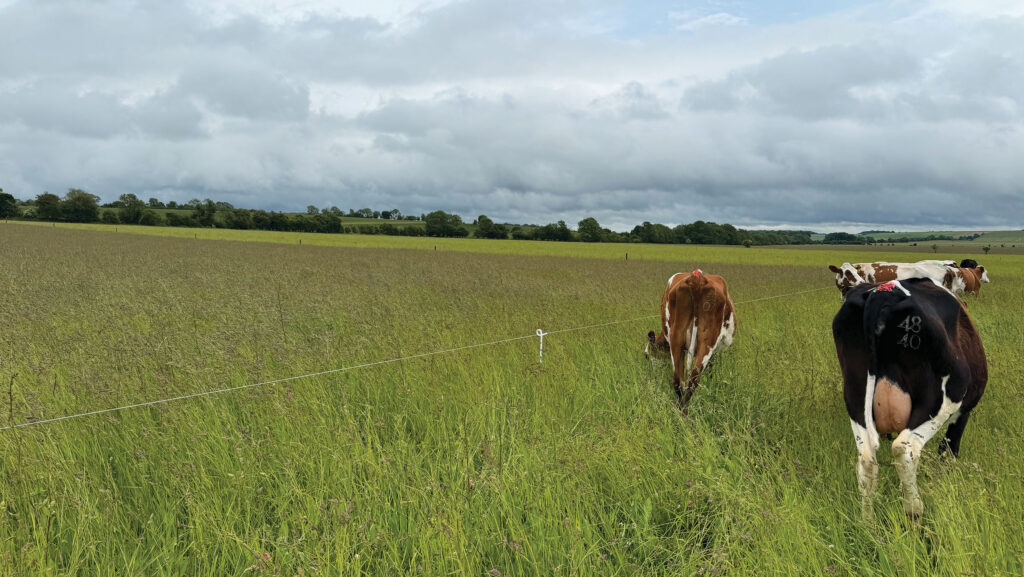
The paddocks during and before grazing © Hayley Chapman
Once-a-day milking
Switching to permanent once-a-day milking in 2022 was always going to mean they would have less milk to sell, but it has brought huge benefits.
“Cell count is better, lameness is better, fertility is better, work-life balance is better, and the cows seem really happy.
“There is no reason not to do it, except for the reduction in yield,” says Dai.
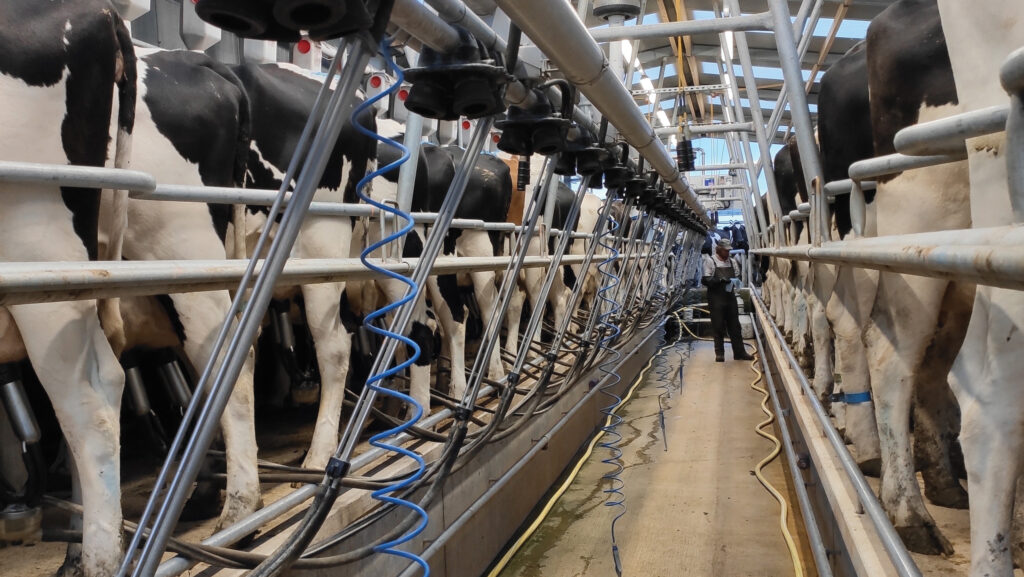
© Sophie Wilson
“If we do 3,500 litres on 200kg of cake, that’s a big chunk of the difference in income saved from feed alone. Plus, you save on electric, labour and other overheads,” he adds.
Milk contract payment terms mean Sophie and Dai are pushing for milk solids rather than yield, so this has influenced breeding decisions.
“Genetics-wise, we are aiming for a three-way cross between a British Friesian, Jersey and VikingRed,” says Sophie.
The goal, according to Dai, is for an average cow size reduction from 600kg to 500kg, while maintaining yield.
All replacements are bred using sexed semen and stock bulls are bred from the farm’s small herd of pedigree Aberdeen Angus cattle, as they are already well adapted to the system.
As well as enjoying their farming system, bringing down overheads is now in sharp focus, looking at shifting fixed costs where possible into variable costs, such as using more contractors where required.
“We want a resilient business, with resilient people and cows, that can cope with imperfect management,” says Sophie.
Outwintering and bale grazing
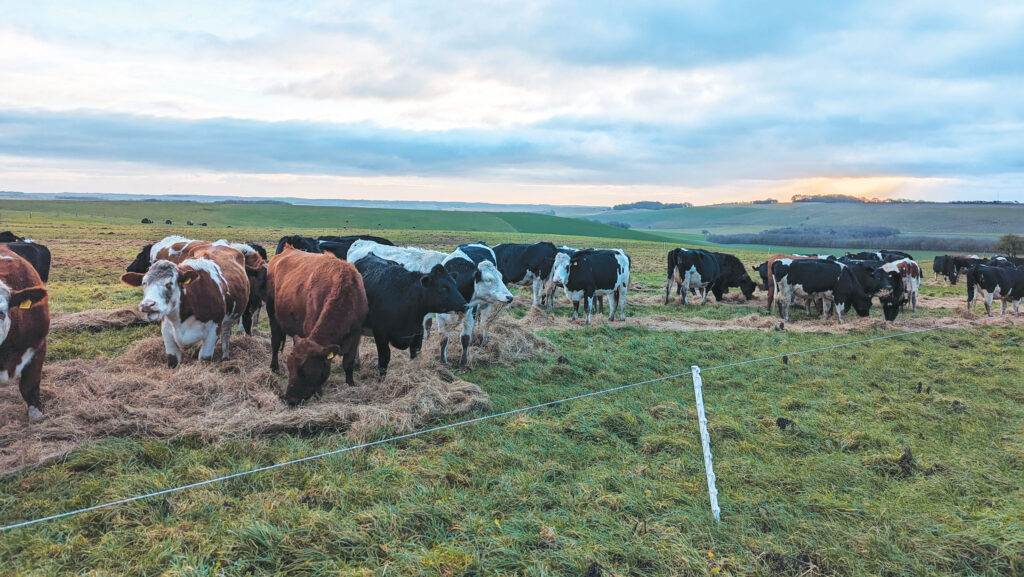
© Sophie Wilson
Most of the cows are outwintered on a block of roughly 162ha (400 acres).
With a typical stocking rate of 480 cows/ha, the ground gets a high density of dung and a long rest period.
Over the course of the winter, 1,500 bales of hay are fed.
“With good planning, we can graze a field in winter, not do any cultivations or reseeding, and then graze it again in spring.
“We unroll bales by hand, back fence, and move troughs so there isn’t poaching,” says Dai Wilson.
“We can be on a field on a really wet day in January and graze it again end of April/early May. There’s a bit of residual hay left, but that just rots down.”
This approach reduces costs, with organic meadow hay fairly easy to source and saves £1,000/week of straw they used to use for bedding when cows were housed.
